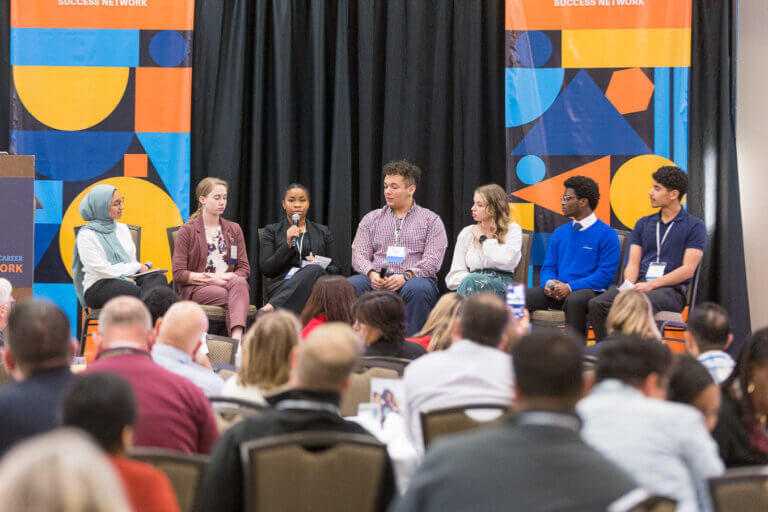Two of the questions we most often get about the Illinois Longitudinal Data System (ILDS) are: What is it? What questions can it answer?
As its name suggests, a longitudinal data system is intended to house data that can be tracked over time, for example, a child’s participation in early childhood programming. A child1 may be in one program as an infant, another program as a toddler, and then a different program when they reach 3 and 4 years old. Eventually, they will enter primary and secondary school, graduate, perhaps go to college, and then enter the workforce. A true longitudinal data system would be able to keep track of an individual across that timeline, but rarely do we have data going back far enough to make all those connections. Instead, we have chunks of data for different individuals across various time periods. Still, these chunks allow us to study many different questions.
Longitudinal data can also include data about individuals’ involvement in health programs, social service programs, or even the criminal justice system —though, for now, Illinois’ system is focused on education and the workforce (including early childhood education).
One aspect that makes a longitudinal data system challenging to implement is that the data necessary is scattered across a variety of state agencies, and we need to work with each agency to develop processes for data requests, data management, and legal agreements. However, agencies rarely have staffing for this work and are instead focused on federal and state mandates that can be required to access millions of dollars in funding. While the ILDS might make that reporting easier at some point, initially, there is a significant yet unfunded lift to standing up the data system.
Making the Case for the ILDS: A Blog Series
In our first blog of the series, “Marking Five Years of Progress: A Status Update for the Illinois Longitudinal Data System,” we overviewed the recent ILDS 2.0 initiative and its accomplishments.
In this entry, we discuss the policy questions that a longitudinal data system can answer.
In the third entry, “Why Do We Need a Longitudinal Data System?,” we address how longitudinal data help answer key policy questions and why sharing data across state agencies is critical.
There are some additional things to note about ILDS that may be different from systems in other states:
- It only has anonymized data, so it cannot be used to track an individual, only groups of individuals.
- It has a matching key that allows data to be matched across agencies and programs. Therefore, it can be used for longitudinal purposes as well as for point-in-time analyses across programs.
- The system is being developed so that research and analytics can occur within a state system. This avoids having to send data files to external entities such as universities or third-party research firms, giving the state and its agencies more control over the data.
Answering Illinois’ Most Challenging Policy Questions
So, what questions can a longitudinal data system answer, and, equally important, what questions can it not answer?
The ILDS cannot answer questions about individuals or support operational uses, such as using FAFSA data to automatically apply a student to community college or sending parents of children in the Child Care Assistance Program information about Preschool for All. These are interesting use cases but require data such as an individual’s name or address that the ILDS does not have.
What the ILDS can answer is some of the most challenging questions facing Illinois as we seek to improve the lives of residents:
- What early childhood services are children recieving over time? Are they receiving similar services in tandem, i.e., Child Care Assistance Program and Preschool for All?
- What are the outcomes of receiving early childhood services? Are students more prepared for school? Do they do better in school over time?
- Do programs such as dual credit, transitional math, or college and career pathways improve students’ outcomes later in life?
- What makes students successful as they transition from high school to college to career? Does education impact wages? Does it lift families out of poverty?
The ILDS can also support questions about foster care, financial aid, workforce training, and course-taking in college and high school. At its core, the goal of the ILDS is to answer questions regarding the life outcomes of individuals who start their educational journey in Head Start, pre-K programs, or using Child Care Assistance and then progress into and through K-12 and then postsecondary.
This is challenging because the data needed to investigate these questions spans agencies, and therefore there is not a single “owner” among those agencies responsible for understanding the outcomes in question. This often means it is incumbent on the Governor’s office and legislature to develop the right questions and facilitate their answers.
Furthermore, they are often challenging to answer because determining if a program or service has caused a particular outcome is very difficult. In statistics, researchers often say “correlation does not equal causation,” but having the data in one place together with robust contextual information, such as demographics and economic status, helps to develop research that is robust, fair, and equitable and can sometimes show causal relationships (i.e., direct and indirect impacts). This can help address a problem we often see with research: there is not enough data to do this nuanced analysis.
While the ILDS is not a cure-all, it is intended to enhance the state’s ability to do research and analytics significantly, and that research can lead to better, more efficient programs. Without it, it is hard to know whether we are serving our residents as well as we can and providing the support necessary for Illinoisians to be successful.


